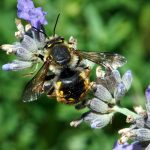
Male Carder Bee
One of the most informative and interesting classes that I attended at this year’s Utah Green Conference, was the Pollinator class given by Jim Cane of Utah State University. When most people think of bees, they think of the fairly recent immigrant to the United States – the European Honey Bee, brought over for it’s honey and wax. In Utah, there are around 900 species of native bees, the vast majority of which are solitary, rather than colony bees. The adult female makes her own nest, with no help. She will divide her tunnel into bee-sized cavities to lay individual eggs, and will most likely spend the winter in her underground home.
Unlike social/colony bees, our native/solitary bees have little venom and little inclination to sting. And, while honey will not result from the labors of solitary bees, they provide valuable pollination for our trees, berries and other fruits. It is also really interesting to see all of the varieties of bees – from large bumblebees to the docile male Melissodes – which can be actually be petted!
Since most solitary bee species nest underground, it is important to leave open soil in our gardens – heavy, continuous bark mulch or weed fabric can hamper the bee’s ability to find and make a home. Other natives will nest in the cavities of hollow cane plants such as raspberry and roses. Many solitary bee species are taxonomic specialists, focusing all of their foraging efforts on one type of flowering plant. Plants to consider to encourage native bees to visit your garden are: Redbud, crabapple, plum and maple trees; Fernbush, Golden Currant and Rabbitbrush shrubs, Russian Sage, lavender, hyssop, goldenrod, globemallow, Sweet Vetch, penstemons, purple clover and buckwheat.
